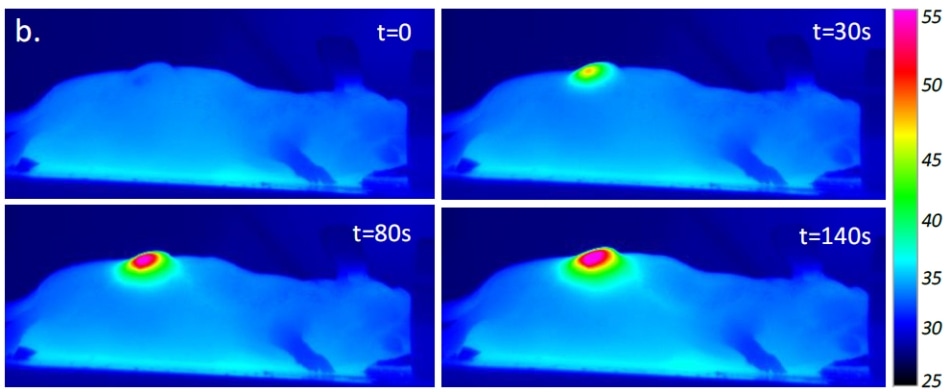Jan 3 2017
 Infrared images showing laser irradiation of nanotube-injected tumor in an anaesthetized mouse. The bar on the right indicates surface temperatures (�C). Credit: Iris Marangon
Infrared images showing laser irradiation of nanotube-injected tumor in an anaesthetized mouse. The bar on the right indicates surface temperatures (�C). Credit: Iris Marangon
Efforts to defeat cancers are often hindered by the mechanical resistance of tumors and collateral damage of standard treatments. However, a group of researchers from the CNRS, the French National Institute of Health and Medical Research (INSERM), Paris Descartes University, and Paris Diderot University have successfully softened malignant tumors by heating them.
This method referred to as nanohyperthermia allows the tumors to be more vulnerable to therapeutic agents. Carbon nanotubes (CNTs) are initially injected directly into the tumors. Next, the nanotubes are activated by laser irradiation, while the surrounding healthy tissue continues to be intact. The research carried out by the team was published in the January 1 issue of Theranostics.
Currently, researchers are focusing on the mechanical factors affecting the development of tumors. Stiffening tumors takes place as a result of the abnormal organization of the collagen fibers and extracellular matrix (ECM) that holds together cells from the same tissue.
This type of stiffening is considered to be a marker of malignancy and can also help cancer cells proliferate and metastasize. Additionally, the ECM develops a physical barrier that restricts tumor penetration by therapeutic agents. A wide range of treatments attempt to disrupt the structure of tumors but turn out to be double-edged swords: as ECM is common to tumors and healthy organs, degrading it causes as much harm as good.
The team however discovered a way around this issue for mouse tumors. CNTs, after being directly injected into the tumors, were activated with near-infrared light. The laser acts only on areas of CNT concentration and heats them up. The researchers used ultrasound shear wave elastography to monitor tumor stiffness. This method uses the shear or secondary wave developed by ultrasound in order to map tissue elasticity.
In two consecutive sessions at a day's interval, the tumors were exposed to nanohyperthermia, or localized heating to 52 °C for 3 minutes. Initially, tumors became increasingly rigid before softening slowly over the 10 days or so that followed the process. Nanohyperthermia denatures collagen fibers locally and decreases the volume and rigidity of tumors over the long term. It also disturbs the tumor microenvironment and may prove efficient as an adjuvant treatment with chemotherapy.
The team members are from the Laboratoire matière et systèmes complexes (CNRS, Paris Diderot University), the Cochin Institute (CNRS, INSERM, Paris Descartes University), the Laboratoire d’immunopathologie et chimie thérapeutique (CNRS), and the Langevin Institute (CNRS, ESPCI Paris).